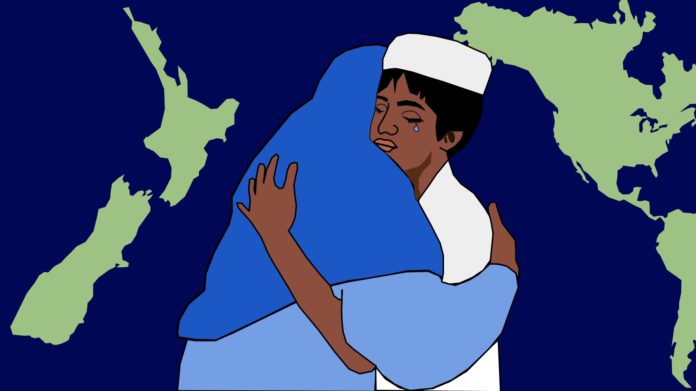There should be little surprise about the recent mosque attack in New Zealand. Sadness, yes. Shock, maybe. Surprise, no.
These continued attacks — in New Zealand, in Quebec, in Pittsburgh — are not “senseless” incidents perpetrated by murderers whose only desire is fame. These terrorists conceive themselves as part of a wider ideological movement of white reclamation, a poisonous narrative that we cannot ignore. These are acts of political terror — perverse, but ideological and always planned to a tee.
The idea that white nationalism solely entails the extinction of non-whites is a strawman that enables apologists to avoid responsibility: if you don’t support Holocaust-style extinction schemes, the reasoning goes, then you can’t be a white nationalist. But in the New Zealand terrorist’s manifesto, there is a subtler but equally malicious narrative at work: that of ethnic “preservation.” Claiming not to hate groups of other backgrounds, the terrorist writes that he only wants groups to remain within their homelands, ensuring that “diverse peoples remain diverse, separate, unique.” Therefore, violence against immigrants is not aggression but self-defense. This is a narrative that American conservatives, including President Donald Trump and US Rep. Steve King (R-IA), partake in.
This narrative is as ahistorical as it is abhorrent.
Ethnicity and nationhood are comparatively new, socially-constructed concepts. They emerged as a result of the 1648 Peace of Westphalia, which laid the groundwork for a modern state system based on territorial sovereignty, and the Enlightenment (1715–1789), which championed the idea that governments should exist for the people and be secular and equal in nature. In theory, personal difference becomes irrelevant in such a society because the political system assures equal treatment for all. But ironically, these developments in political thought only amplified division. Before, people existed as subjects in empires where few longed for a coherent national identity. But this new idea of a government “for the people” raised the question of who constitutes “the people.”
Over time, these new questions and doubts led to problems for the large, non-representative, multi-ethnic empires that dominated the political scene pre-Enlightenment. Conceptions of self and community begin changing to align with the political innovations of the past century, as imperial subjects began to demand that governments reflect their interests and the interests of others with whom they identified. This idea of group identification morphed into the idea of nationhood: that one belongs to a shared community, a “nation of people”defined by some combination of religion, language and “culture.” In tandem emerged the idea that each “nation” deserves its own representative government. This spelled doom for imperial governments such as the Ottoman Empire, which housed many “nations.” The Serbs revolted in 1804, the Greeks revolted in 1821, and so on and so on until the empire that once stretched three continents was no larger than modern-day Turkey by 1923.
The development of a nation-state is exclusionary by its very nature. If a state is for some people (say, the Serbs), then it is not for others (anyone not considered “Serbian”). Groups inside your state belonging to different “nations” become immediately suspect; you assume that their loyalties lie elsewhere, and that their presence within your state can only be detrimental. To protect your state, violence becomes acceptable. The 1915 Armenian Genocide is a prime example. The Ottoman Empire — in a last-ditch attempt to brand itself as a state for the Turkish people — sought to relocate and exterminate its “ethnic Armenian” minority.
We can see how exclusionary movements such as white supremacy manifest the contradictions of nationhood and the modern nation-state system. White supremacy conceives itself as the defender of white nation-states, the guardian of a white, Christian West. In the process, it others minorities by painting them as enemies within. We can see this in the manifesto, where the terrorist claims that diversity harms whites — “DIVERSITY IS WEAK, UNITY IS STRENGTH,” he writes.
We should condemn white supremacy for the racial violence it propagates, but we also have the power to debunk it: Its claims to historical roots have no factual basis. White supremacists crave a spot at the debate table of modern ideologies. By looking at history, we can deny them that legitimacy. The inception of the “white nation” has a very clear historical starting point; it does not exist as some sort of pure, eternal and historically contiguous society. These are narratives constructed to divide people into neat “us” vs. “them”categories, ignoring the fact that history has not spared a single group from the influence of others. “Islam” and “the West” intermingled in the days of ancient empires, they intermingled in the Cold War, and they’ve intermingled amid the contemporary geopolitics of the Middle East. Histories and identities exist as products of interaction, not isolation.
We must be cautious that in condemning the recent New Zealand attack, we don’t reinforce the same dichotomies that created it. It’s tempting to claim that the white supremacist is “not us.” But in doing so, we gloss over the West’s culpability in creating conditions of violence. When we construct a dichotomy between the West’s “true essence” and the scourge of white supremacy, we remove the distinct historical and political developments that distinguish white supremacy as an offshoot of Western political thought, reinforced through racist policy. A similar East-West dichotomy has allowed the West to eschew responsibility for its role in the Cold-War era financing of many of the Islamist groups that have morphed into today’s terror networks. It’s easy to paint the enemy you’re fighting as your distant, evil arch-nemesis; it’s harder to acknowledge that you helped create that enemy and that you bear responsibility for its strength.
It is time to confront the monster we have created. Until we do so, those dead at the hands of white supremacy will only continue to increase in number, each body a reminder of our complicity, our apathy and our hypocrisy.
Zach Goodwin is a sophomore Diplomacy and World Affairs major. He can be reached at zgoodwin@oxy.edu.
![]()



































